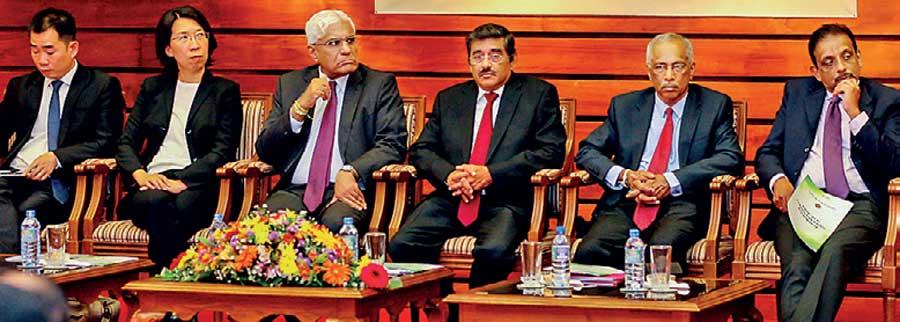20 Jun 2019 - {{hitsCtrl.values.hits}}

From left: SynTao Green Finance Chairman Dr. Guo Peiyan, IFC Sustainable Banking Network Asia Coordinator Wei Yuan, CB Governor Dr. Indrajit Coomaraswamy, CB Senior Deputy Governor Dr. P. Nandalal Weerasinghe, CB Deputy Governor H.A. Karunaratne and CB Deputy Governor S.R. Attygalle
Pic by Damith Wickramasinghe
By Nishel Fernando
The Central Bank (CB) mulls setting up a joint committee consisting of the regulatory and non-regulatory stakeholders of the financial industry to ensure the full implementation of the recently launched Roadmap for Sustainable Finance in Sri Lanka by 2030.
“The Central Bank is now in the process of operationalising the roadmap in line with the stipulated time frames and targeted actions. We have already set up a steering committee within the Central Bank to implement the roadmap and to monitor the progress.
Going forward, we are contemplating establishing a committee consisting of the regulatory and non-regulatory stakeholders of the sustainable finance initiative, reinforcing the shared responsibilities and commitments,” CB Governor Dr. Indrajit Coomaraswamy said.
He made these remarks yesterday, delivering the keynote speech at the launch of the ‘National Roadmap for Sustainable Finance’, at the CB premises.
Dr. Coomaraswamy noted that the CB is in the process of developing the necessary frameworks that support the market and financial institutions adopt good practices in delivering sustainable finance.
The CB is currently considering formulating the necessary regulations to incentivise the financial institutions to practice sustainable finance actively.
As the banking sector regulator, the CB is evaluating a set of tools to develop a sustainable finance framework, which ranges from assigning preferential risk rates under Basel III to subsidising loan rates for priority sectors to imposing credit floors and credit ceilings.
“We are now evaluating the need to introduce such tools to promote this endeavour. The measures such as preferential risk rates under Basel III for sustainable friendly business activities are being examined at present,” CB Bank Supervision Department Director A.A.M. Thassim said.
However, he noted that it would be challenging for the banking sector to embed sustainable finance to bank’s business while creating business drivers for sustainable banking.
“There can be perceptions that green lending potentially raise costs. Accordingly, we may need to address motivational, technical and financial barriers to promote sustainable finance,” he added.
Speaking at the occasion, SynTao Green Finance Chairman Dr. Guo Peiyan emphasised that the banks can no longer rely on purely financial elements in their risk management while stressing that banks need to adopt a different structure to manage the risk by incorporating social and environmental risks for their sustainability.
According to him, the environmental and social risks consist of credit, liability and reputational risks for banks.
Further, Dr. Guo also noted that the banking sector CEOs need to consider asset level risk management as some banks might be exposed to higher than environmental and social risk than they appear to be.
Touching on the opportunities for banks in sustainable finance, IFC Sustainable Banking Network Asia Coordinator Wei Yuan illustrated how China’s Industrial Bank evolved from a regional bank to a second tier bank in China, by adopting the sustainable financing framework.
She noted that Industrial Bank spearheaded the sustainable finance initiative in China.
Meanwhile, Dr. Coomaraswamy asserted that the policymakers need to act decisively without any delay to deal with climate-related shocks that could deliver deadly blows to financial systems.
“Accordingly, adhering to sustainable finance practices is now considered as a critical component of the development agenda to ensure a sustainable future for our future generations,” he said.
Sri Lanka is facing increasing environmental and climate challenges with frequent natural disasters and such could hinder the country’s sustainable economic growth.
Yuan noted that Sri Lanka may face a 1.2 percent loss of annual GDP by 2050, if measures are not taken to address climate change.
Therefore, Dr. Coomaraswamy emphasised that the Roadmap for Sustainable Finance would play a critical role in mitigating these adverse climate-related shocks.
The Roadmap for Sustainable Finance was initially unveiled globally on April 10, this year, at the Sustainable Banking Network Global Meeting of the International Finance Corporation (IFC) in Washington, D.C, USA.
The roadmap was developed in consultation with the stakeholders including the Sri Lanka Bankers’ Association (Guarantee) Ltd, Finance Houses Association of Sri Lanka, Insurance Regulatory Commission of Sri Lanka and Securities and Exchange Commission of Sri Lanka.
Further, the IFC served as the secretariat and technical advisor and the United Nations Development Programme provided financial support through its Biodiversity Finance Initiative to the Central Bank in designing the Sustainable Finance Roadmap.
25 Nov 2024 52 minute ago
25 Nov 2024 1 hours ago
25 Nov 2024 1 hours ago
25 Nov 2024 2 hours ago
25 Nov 2024 3 hours ago